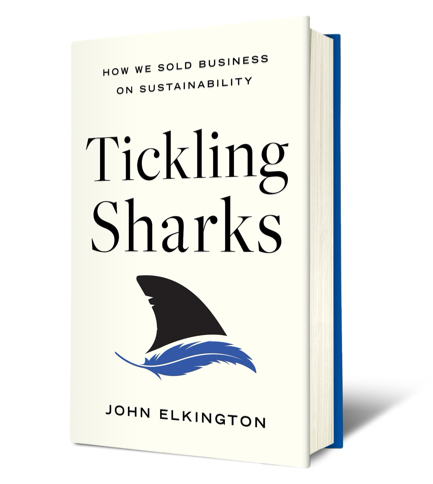How To Rock Tomorrow’s Competitive Arenas
18 “arenas” will transform business and markets, say McKinsey
If we are to have any hope of bending some of the critical curves shaping tomorrow’s economy, with the goal of making it more sustainable, then we need a better sense of what that economy—or those economies—will look like. We also need to identify potential gamechangers, individual and organizational, early enough in the process to help shape how they think and what they then try to do to create future forms of value.
One way to identify tomorrow’s movers and shakers is to absorb the best of current market forecasts—albeit always with a healthy dose of scepticism. Which is what brought to me to a new McKinsey Global Institute report, The Next Big Arenas of Competition.
Two things define “arenas,” they say: high growth and dynamism. In a pattern that most of us will readily recognize, these “capture an outsize share of the economy’s growth, and the market shares of players within them change to an outsize degree.”
Along the way, we are introduced to no less than 18 potential “arenas of the future” that McKinsey think could reshape the global economy—generating $29 trillion to $48 trillion in revenues by 2040.
Who among us is already in the game?
One key question is who is among is currently engaging the innovators, entrepreneurs and investors driving these emerging arenas—to ensure that challenges like the climate and biodiversity emergencies, cyber privacy and human rights are on their priority lists? Apart from a few players like RethinkX, my sense—and if I’m wrong here, please let me know—is that there is a howling opportunity space that we need to occupy as soon as possible.
So how do such arenas get going in the first place? Indeed, is there an “arena-creation potion” for creating them? Key ingredients when whisking up a new arena, according to McKinsey, are “a business model or technological step change, incentives for escalatory investments—those that improve quality and often have increasing returns to scale—and a large or growing addressable market.”
So far, so reasonably obvious. But the examples identified will be a useful prompt to would-be changemakers and future-shapers considering how they can best use their limited resources. The emerging arenas flagged range from AI software and services to cybersecurity, from future air mobility to drugs for obesity and related conditions, and from robotics to nonmedical biotechnology.
Taken together, we are told, these new arenas could generate $2 trillion to $6 trillion in profit by 2040. Even more striking, their collective share of global GDP could increase from 4 percent today to 10 to 16 percent by 2040. One key growth dynamic is that arenas earn far greater profits than other industries do, spawning a disproportionate number of global giants, and offering unusually strong opportunities for new entrants to become future powerhouses.
Time to get in on tomorrow’s ground floor
In terms of where we have been, twelve of today’s arenas showed outsize growth and dynamism between 2005 and 2020. They include e-commerce (think Amazon), biopharma (Eli Lilly or Novo Nordisk), electric vehicles (Tesla or BYD), consumer internet (Alibaba), and cloud services (Microsoft).
Together, these arenas had a revenue CAGR (compound annual growth rate) of 10 percent and market capitalization CAGR of 16 percent and tripled their global GDP share from 3 to 9 percent in the period. By contrast, “non-arenas” had only a 4 percent revenue CAGR and a 6 percent market cap CAGR over the same period.
In terms of the arenas likely to shape the future, the McKinsey 18 include: semiconductors, artificial intelligence (AI), cloud, electric vehicles, shared autonomous vehicles, future air mobility, batteries, robotics, e-commerce, digital ads, streaming video, video games, cybersecurity, modular construction, obesity drugs, non-medical biotech, nuclear fission, and space.
If the past is any guide, these arenas will be crucibles of intense and growing competition, innovation, value creation and—often overlooked until it is too late, impact.
Zeroing in
So, what does the future look like when you zero in a bit? Let’s unpack just one of the 18 arenas, nonmedical biotechnology.
I was involved in biotechnology for over 15 years, working with companies like Novo Nordisk and editing an industry newsletter. Over time, I became somewhat jaundiced about market forecasts, which served to boost investment on the way up—but often looked delusional when the inevitable corrections set in.
That said, considerable opportunities are foreseen in at least four key areas where biotech companies operate—noting that Novo Nordisk span out its nonmedical biotech activities in 2000 as Novozymes, which recently combined forces with Chr. Hansen to create Novonesis.
The four are:
alternative proteins (including cultured meat and microbial protein);
agricultural biotechnology (including genetically modified animals and crops and selective breeding of both crops and animals using genetic markets);
consumer products and services (including personalized genetics, probiotics and DNA-based diets); and
biomaterials and biochemicals (including bioplastics, bio-based additives for feed and food, and microbial crop protection).
There are no great surprises in the McKinsey listing of future arenas, or perhaps even in the underlying analysis, and—at least for me—one of the most interesting questions is how these different sectors will catalyze and feed off one another. Think AI, data farms and the growing interest of companies like Amazon and Google in modular nuclear reactors, alongside Microsoft’s interest in reviving old pressurized water reactor (PWR) sites like Three Mile Island.
Who would have thought?
Meanwhile, anyone working on new strategies for sustainability-based organizations could find the report useful when thinking about where they might best leverage tomorrow’s economy-shaping trends to rock—and repurpose—tomorrow’s arenas.
John Elkington is Founder & Chief Pollinator at Volans. His personal website can be accessed here. His latest book is Tickling Sharks: How We Sold Business on Sustainability (Fast Company Press, 2024).
What readers say:
“By coaching the enlightened—and confronting the laggards—John has helped put the issues and opportunities firmly on the top tables of some of the world’s largest and most impactful businesses.”
SIR DAVE LEWIS, former CEO, Tesco PLC; chair, WWF-UK
Available on Amazon and through good bookshops.






I think this is a very interesting and does present great challenge. The aspect in getting a bridge between the innovators and the challenges is a constant conundrum to me. Obviously I try in a small way at Anthropy to encourage this, but trying to get certain people , even the likes of McKinsey, to come and share thinking in order to drive new opportunities etc, is a massive uphill struggle. But thanks for sharing👍🏻